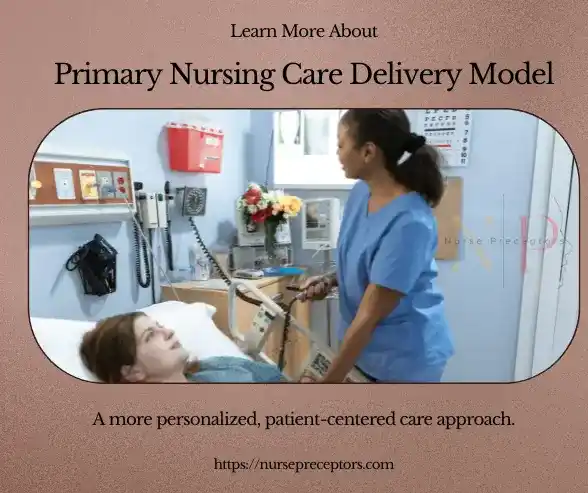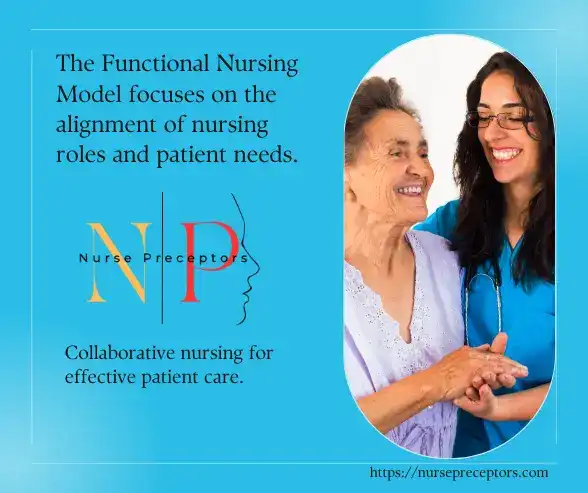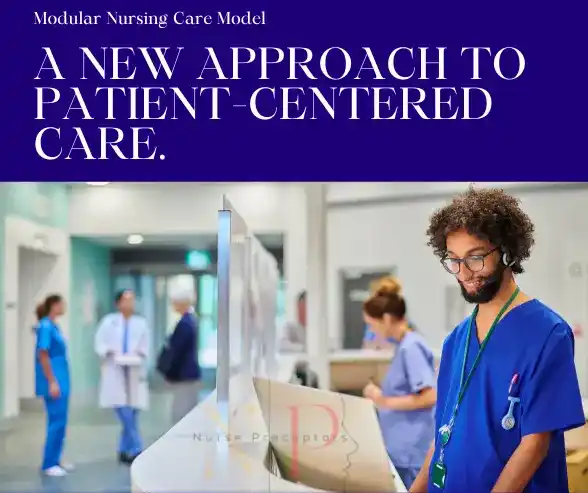What is nursing care delivery system?
Nursing Care Delivery Systems are frameworks designed to organize and coordinate care provided to patients across various settings. These systems are designed to provide patients with comprehensive, efficient, and effective nursing care that corresponds to their specific health needs.
The primary objective of these systems is to ensure the delivery of safe, quality, and efficient nursing care to all patients, irrespective of their health conditions or personal circumstances.
The structure of the delivery system can have a significant impact on the effectiveness of the nursing care provided, patient outcomes, and overall healthcare experience. These nursing care delivery systems operate on multiple levels and involve various functions.
- At the individual level, it includes direct patient care, medication administration, patient education, and the coordination of care with other healthcare professionals.
- On the organizational level, it encompasses the designing and implementing policies and procedures that govern nursing practice within a healthcare institution.
- At the societal level, it involves advocating for the rights and welfare of patients within the broader healthcare policy environment.
Despite different levels, there are several types of nursing care delivery models, including primary nursing, team nursing, and case management nursing.
Every model has its unique characteristics and benefits. For instance, primary nursing emphasizes the establishment of a therapeutic relationship between a nurse and a patient, which facilitates individualized care, trust, and continuity of care.
On the other hand, team nursing involves a group of nurses working together to provide care to multiple patients, which promotes collaboration and resource sharing.
By understanding the different models of the nursing care delivery system, healthcare institutions can choose the most appropriate model that aligns with their mission, values, and patient population.
Regardless of the chosen model, it is crucial to ensure that it promotes patient-centered care, professional collaboration, and continual quality improvement.
Types of nursing care delivery systems
There are various types of nursing care delivery systems, each with its own characteristics and organizational structure. The choice of a particular system depends on factors such as the type of healthcare facility, the nature of patient needs, and the available resources. Here are some common types of nursing care delivery systems:
- Team Nursing
- Primary Nursing
- Total Patient Care (Case Method)
- Functional Nursing
- Modular Nursing
- Case Management
1. Team Nursing Care Delivery Model
The Team Nursing Care Delivery Model is a nursing care delivery system that involves organized nursing care within a healthcare setting. In this model, a team of healthcare professionals collaboratively provides patient care.
The team generally includes Registered Nurses (RNs), Licensed Practical Nurses (LPNs), Nursing Assistants, and other supporting staff. Following are the characteristics of Team Nursing Care Delivery Model:

While the Team Nursing Care Delivery Model has its advantages, it’s essential to note that different healthcare settings may prefer or adopt alternative care delivery models based on their specific needs and priorities.
The choice of a care delivery model depends on factors such as the size of the healthcare facility, the complexity of patient cases, and the available resources.
2. Primary Nursing Care Delivery Model
The Primary Nursing Care Delivery Model represents a significant shift in healthcare delivery, emphasizing continuity of care, delegation, and the nurse-patient relationship.
It is a patient-centered approach that assigns one nurse, known as the primary nurse, to oversee and coordinate all aspects of an individual patient’s care throughout their stay in a healthcare facility.
This model was designed to enhance the quality of care by fostering a closer bond between patients and their nurses, thereby improving patient satisfaction and outcomes. Following are the characteristics of Primary Nursing Care Delivery Model:

The Primary Nursing Care Delivery Model aims to enhance care quality and patient satisfaction while improving health outcomes by adopting a personalized and patient-focused approach to nursing.
3. Total Patient Care (Case Method)
Total Patient Care, often referred to as the Case Method, is an approach to healthcare that emphasizes comprehensive and holistic patient management.
In this method, healthcare professionals, particularly nurses, take responsibility for the overall care of an individual patient throughout their entire healthcare journey. The goal is to provide seamless and integrated care, considering the physical, emotional, social, and spiritual aspects of the patient. Following are the Characteristics of Total Patient Care (Case Method):

Total Patient Care is often contrasted with other models, such as Team Nursing or Functional Nursing, which may involve a more fragmented approach to patient care.
The Case Method is particularly prevalent in settings where personalized and comprehensive care is essential, such as in critical care units, long-term care facilities, or when dealing with complex and chronic health conditions.
4. Functional Nursing Model
The Functional Nursing Model is a nursing care delivery system that divides patient care tasks among different nursing staff based on their specific skills and expertise.
In this model, each nurse or healthcare professional is assigned specific tasks or functions to perform for a group of patients. The goal is to efficiently utilize the skills of the healthcare team and streamline the delivery of care. Following are the characteristics of Functional Nursing Model:

The Functional Nursing Model contrasts with other care delivery models, such as Total Patient Care (Case Method) or Team Nursing, where the emphasis is on providing holistic and comprehensive care for individual patients.
While the Functional Nursing Model can enhance efficiency in certain healthcare settings, it may be less suitable for situations where personalized and holistic care is a priority, such as in critical care units or when dealing with patients with complex health conditions.
Each care delivery model has its strengths and weaknesses, and the choice of model depends on factors such as the nature of the healthcare setting, patient population, and organizational preferences.
5. Modular Nursing Care Model
The Modular Nursing Care Model is a nursing care delivery system that combines elements of both functional and team nursing. In this model, patient care is organized into modules, with each module comprising a team of healthcare professionals led by a registered nurse.
This approach aims to provide comprehensive and patient-centered care while optimizing the use of the healthcare team’s skills and resources. Following are the characteristics of Modular Nursing Care Model:

The Modular Nursing Care Model aims to balance task-oriented care and a patient-centered approach through team nursing. By organizing care into modules, it aims to provide a more coordinated and responsive system that can adapt to the unique needs of patients and the healthcare setting.
Like any care delivery model, its success depends on factors such as the nature of the patient population, the healthcare setting, and the effectiveness of communication and collaboration within the healthcare team.
6. Case Management Nursing Model
The Case Management Nursing Model is a method of healthcare delivery that focuses on organizing and supervising the care of patients through multiple healthcare settings.
Case managers, generally registered nurses with specialized training, are the key players in this model. Their primary responsibility is to ensure that patients receive timely and appropriate care while making the best use of the resources available and promoting positive health outcomes. Following are the characteristics of Case Management Nursing Model:

The Case Management Nursing Model is especially suitable in healthcare systems where patients receive care from different providers across different settings.
The model aims to improve the quality of care, enhance patient satisfaction, and ensure the efficient use of healthcare resources. It is commonly used in situations such as caring for individuals with chronic illnesses, post-surgical care, or transitioning between hospital and home care.
Comparison of different nursing care delivery models
Various nursing care delivery models exist, each with its approach to organizing and providing patient care. Here’s a comparison of several common nursing care delivery models:
Total Patient Care:
- Focus: Individual patient care, holistic approach.
- Responsibility: The individual nurse takes overall responsibility for the patient’s care.
- Communication: Close communication with the patient and their family.
- Setting: Often used in critical care or with complex health conditions.
- Pros: Personalized care, continuity, and a holistic approach.
- Cons: Resource-intensive, may be less efficient in high-volume settings.
Team Nursing:
- Focus: Shared responsibility for patient care among a team.
- Responsibility: Tasks are divided among team members, led by a registered nurse.
- Communication: Regular communication and collaboration among team members.
- Setting: Common in general medical-surgical units.
- Pros: Efficient use of personnel, good communication.
- Cons: Potential for fragmented care, dependence on effective teamwork.
Functional Nursing:
- Focus: Task-oriented care, specialized functions.
- Responsibility: Nurses specialize in specific tasks (e.g., medication administration, wound care).
- Communication: Limited direct interaction with patients; communication is task-specific.
- Setting: Often used in settings with high patient volumes.
- Pros: Efficient use of skills, and task specialization.
- Cons: May lack a holistic view of the patient, potential for fragmented care.
Primary Nursing:
- Focus: Individual patient care, continuity, and a personal relationship.
- Responsibility: One primary nurse takes overall responsibility for the patient.
- Communication: Close communication between the primary nurse, patient, and healthcare team.
- Setting: Common in specialty units or settings with long-term relationships.
- Pros: Personalized care, continuity, strong nurse-patient relationship.
- Cons: Resource-intensive, the potential for increased workload.
Modular Nursing:
- Focus: Care is organized into modules with a team led by a registered nurse.
- Responsibility: Division of tasks within the team; registered nurse provides oversight.
- Communication: Effective communication within and between modules.
- Setting: Offers flexibility and adaptability in various healthcare settings.
- Pros: Combines efficiency with a team approach, adaptable to changing needs.
- Cons: Requires effective communication and coordination.
Case Management:
- Focus: Coordinating care for a group of patients across settings.
- Responsibility: Case managers ensure the efficient delivery of services and resources.
- Communication: Coordination among various healthcare providers and services.
- Setting: Often used in chronic disease management and post-acute care.
- Pros: Optimizes resources, and focuses on patient outcomes.
- Cons: It may involve less direct patient care, and requires strong coordination skills.
Conclusion
In conclusion, nursing care delivery systems play a pivotal role in the healthcare setting. Their effectiveness and efficiency directly influence patient outcomes and satisfaction, making them an integral part of healthcare provision.
These systems include various models, such as primary nursing, team nursing, and patient-centered care, each with its own set of advantages and disadvantages.
However, the successful implementation of these nursing care delivery systems hinges on a plethora of factors. Adequate staffing levels, appropriate skill mix, ongoing training, and institutional culture are just a few of these critical elements.
Without these fundamental requisites, even a well-designed system can fail to deliver expected outcomes.
In essence, nursing care delivery systems are not static constructs. They evolve in response to changes in healthcare needs, technological advancements, and policy shifts.
Hence, it is crucial for healthcare institutions to regularly review and update their nursing care delivery systems to ensure they remain effective and relevant.
References:
- Silvestri, L. A. (2023). Saunders Comprehensive Review for the NCLEX-RN examination 2023. Elsevier.
- Nursing Care Delivery System. Johns Hopkins Medicine. (n.d.). https://www.hopkinsmedicine.org/all-childrens-hospital/health-professionals/nursing/johns-hopkins-all-childrens-nursing-care-delivery
- Berman, A., Kozier, B., Erb, G. L., Snyder, S., Levett-Jones, T., Dwyer, T., Hales, M., Harvey, N., Langtree, T., Moxham, L., Parker, B., Reid-Searl, K., & Stanley, D. (2018). Kozier and Erb’s fundamentals of nursing: Concepts, process and Practice. Pearson Australia.
- DeLaune, S. C., & Ladner, P. K. (2002). Fundamentals of Nursing: Standards and Practices. Delmar.
- Weiss, S. A., & Tappen, R. M. (2015). Essentials of nursing leadership and management. F.A. Davis Company.
- Potter, P. A., Perry, A. G., Stockert, P. A., & Hall, A. (2019). Essentials for nursing practice. Elsevier. Team nursing model – what it is and how to make it work. Team Nursing Model | Lippincott NursingCenter. (n.d.). https://www.nursingcenter.com/ncblog/december-2020/team-nursing-model
*We express our gratitude towards the various sources referred in this blog post for their valuable contributions and insights. Their expertise and dedication have significantly enriched the content, and we extend our sincere appreciation to each of them for their valuable contributions.